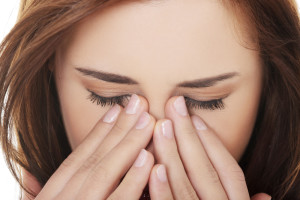 Over thousands of years, Traditional Chinese Medicine (TCM) has defined some special headache patterns in addition to those conventional medicine defines.
Over thousands of years, Traditional Chinese Medicine (TCM) has defined some special headache patterns in addition to those conventional medicine defines.
While TCM clearly identifies migraine, TCM further refines migraine patterns that include eye pain complaints. For example, a usually one-sided, sharp headache pain that starts at the base/back of the skull and travels either through or over the head to behind the eye on the same side is called a Yang Wei Mo headache. There is a special meridian/needle plan for treating this very specific pain pattern that is rather effective. [2]
There is another pattern in the “goggle” distribution. Usually, this pain is felt in or behind both eyes simultaneously, and is often exclusively on either the inside or the outside portions of both eyes. This headache, called a Yin Qiao Mo/Yang Qiao Mo headache, also has a collection of very specific points to address it.
Lastly, there are headaches that often, but not always, start after a sacral or coccygeal (tailbone) injury. Often, there is a one-time pain that travels from the tailbone to the head. After that pain resolves, ongoing daily, dull headaches may ensue. Special points overlying the sacrum, spine and scalp can bring great relief to this condition.
Body and ear acupuncture are the mainstays of treatment for these headaches. Trigger Point Therapy, cupping, gua sha, Neurological/ Scalp Acupuncture, Chinese Herbal Medicine, and/ or pharmaceuticals may also assist to alleviate these conditions. [2]
X
These brief overviews of conditions represent distillations of basic and current medical reviews from the following sources:
[1] Conventional Medical Sources
“Harrison’s Principles of Internal Medicine: Volumes 1 and 2, 18th Edition”. Dan Longo Anthony Fauci, Dennis Kasper, Stephen Hauser, J. Jameson, Joseph Loscalzo. McGraw-Hill Professional; (July, 2011)
Medscape eMedicine Physician’s online resource. Various review articles accessed June 2013:
Migraine Headache
Jasvinder Chawla, MD, MBA Chief of Neurology, Hines Veterans Affairs Hospital; Associate Professor of Neurology, Loyola University Medical Center
Tension Headache, Cluster Headache
Michelle Blanda, MD Chair, Department of Emergency Medicine, Summa Health System Akron City/St Thomas Hospital; Professor of Emergency Medicine, Northeastern Ohio Universities College of Medicine
Temopromandibular Joint Disorders
Charles F Guardia III, MD Instructor in Neurology, Department of Neurology, Dartmouth Hitchcock Medical Center, Geisel School of Medicine at Dartmouth
Trigeminal Neuralgia
Manish K Singh, MD Assistant Professor, Department of Neurology, Teaching Faculty for Pain Management and Neurology Residency Program, Hahnemann University Hospital, Drexel College of Medicine; Medical Director, Neurology and Pain Management, Jersey Institute of Neuroscience
[2], [3] “Acupuncture Energetics: A Clinical Approach for Physicians”. Joseph M. Helms. Medical Acupuncture Publishers; 1st Edition. (1995)
- “Foundations of Chinese Medicine: A Comprehensive Text for Acupuncturists and Herbalists”. Giovanni Maciocia. Churchill Livingstone; 2 Edition (July, 2005).
- “Diagnosis in Chinese Medicine: A Comprehensive Guide”. Giovanni Maciocia. Churchill Livingstone; 1st Edition (January, 2004).
[4] “Chinese Scalp Acupuncture”. Jason Ji-shun Hao, Linda Ling-zhi Hao and Honora Lee Wolfe. Blue Poppy Press; 1st Edition. (November, 2011)
